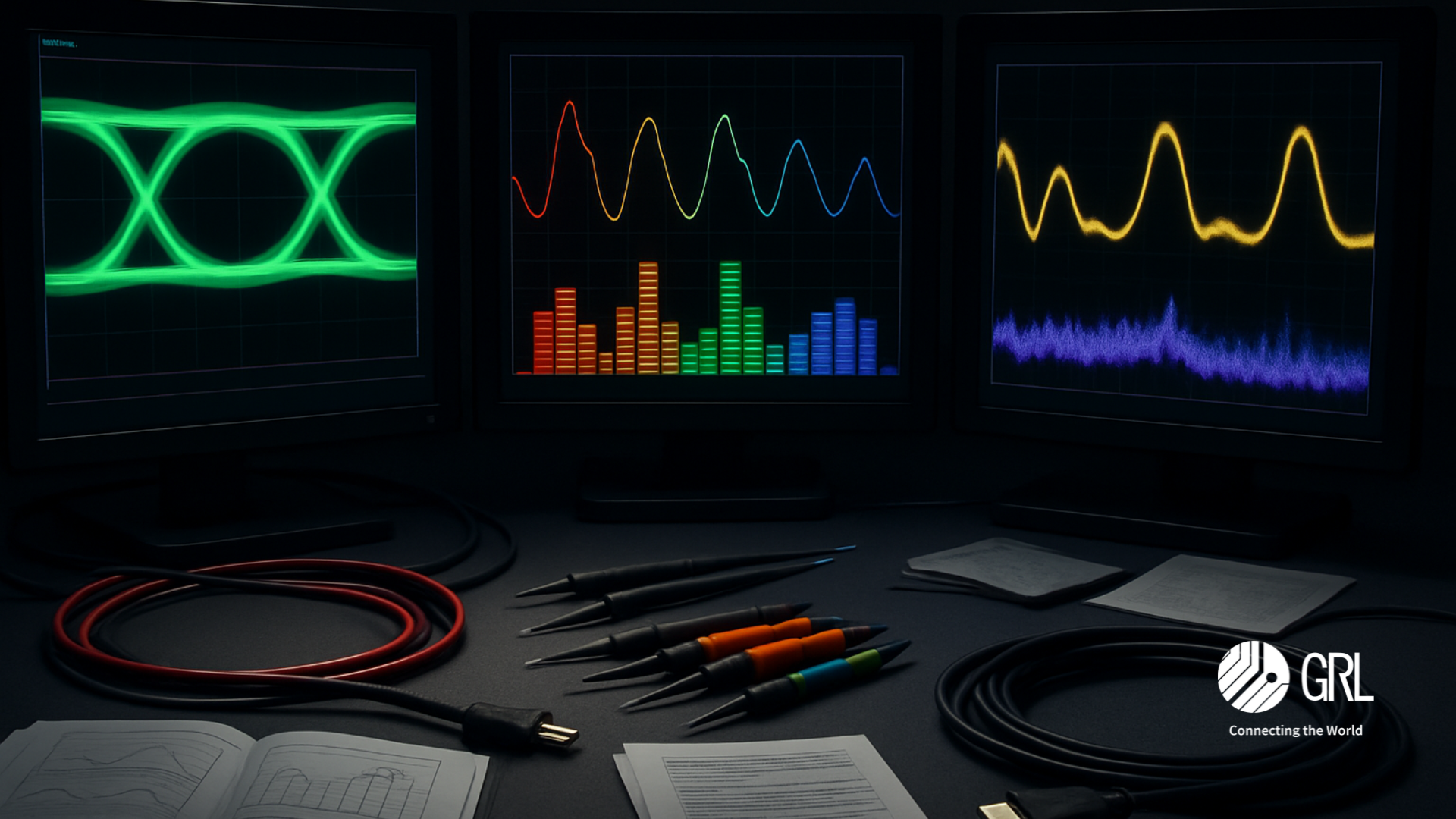The highly anticipated HDMI® 2.2 Specification is expected to mark a significant leap forward in bandwidth and display capabilities. As the successor to HDMI® 2.1 Specificaton, the new standard doubles the maximum data rate to 96 Gbps, enabling support for uncompressed 4K at 240Hz, 8K60 4:4:4, and up to 12K resolutions via DSC. These enhancements are set to meet the growing demand for high refresh rate gaming displays, immersive extended reality (XR) environments, and advanced content creation tools.
According to the HDMI Licensing Administrator, Inc. (HDMI® LA), almost 14 billion HDMI® enabled devices have been shipped since the first HDMI specification was released in December 2002, highlighting the technology’s continued dominance across consumer and professional markets. Early preparation for HDMI® 2.2 Specification compliance requirements, interoperability challenges, and long-term market implications can help players in the high-speed interface testing and certification space gain an early advantage as we navigate this next transition.
In this article, we break down the key updates of HDMI® 2.2 Specification and what development teams should consider ahead of commercial deployment and certification.
Three technical upgrades in HDMI® Specification Version 2.2
The HDMI 2.2 specification is built upon three pillar features designed to meet the A/V demands of the next decade.
1. Bandwidth Doubled to 96Gbps with Next-Gen FRL
The most significant update is the doubling of the maximum bandwidth from 48Gbps in HDMI ® 2.1 Specification to a massive 96Gbps. This is achieved through a next-generation Fixed Rate Link (FRL) technology, unlocking unprecedented video and audio capabilities, including:
- Support for higher uncompressed formats: Natively supports ultra-high-quality video like 4K@240Hz and 8K@120Hz without compression.
- Expanded resolution support with Display Stream Compression (DSC): Thanks to visually lossless Display Stream Compression (DSC), HDMI® 2.2 Specification extends support to ultra-high-resolution formats previously unattainable. This includes 8K at 240Hz, 10K at 120Hz, and even 12K at 120Hz, providing the bandwidth headroom needed for future display technologies across gaming, digital signage, XR, and professional content creation.
- Optimized for high-bandwidth professional and commercial applications: HDMI® 2.2 Specification delivers the performance required for data-intensive use cases such as AR/VR/MR, medical imaging, and large-format digital signage, offering a future-ready foundation for next-generation display ecosystems.
2. Introducing the Ultra96 HDMI® Cable and Certification Program
The new Ultra96 HDMI® Cable supports the 96 Gbps bandwidth of HDMI® 2.2 Specification. The cable will form part of the updated updated HDMI Ultra Certification Program, where every cable—regardless of model or length—must pass comprehensive compliance testing before being permitted to enter markets. This requirement ensures product integrity for end users and underscores the essential role of accredited test labs in maintaining ecosystem reliability. The Ultra96 HDMI® Cable is expected to become commercially available in Q3 to Q4 of 2025.
3. Addressing A/V sync challenges with Latency Indication Protocol (LIP)
Audio/video synchronization issues remain a persistent challenge in complex A/V signal chains—particularly in multi-hop configurations where signals pass through multiple devices such as gaming consoles, AV receivers, and displays. With the introduction of the Latency Indication Protocol (LIP), HDMI® 2.2 Specification provides a standardized mechanism for source and sink devices to exchange latency information. This allows systems to apply precise, adaptive audio or video delays, significantly improving synchronization across the signal path and enhancing the end-user experience in both consumer and professional environments.
Comparison of HDMI® Specification Versions 1.4, 2.1 and 2.2
Changes in features from HDMI® specification version 1.4 to verion 2.1 and now version 2.2 are as follows:

HDMI® Specification Version 2.2 Testing and Certification Challenges
The HDMI® 2.2 Specification is anticipated to introduce significant challenges across the following domains:
1. Physical Layer (PHY) testing
- Signal Integrity: The new HDMI® 2.2 Specification 96 Gbps data rate significantly raises the bar for signal integrity requirements. Ensuring reliable performance at this level will demand precision in next-generation test methodologies and equipment capable of analyzing key metrics such as eye diagrams, jitter, insertion loss, and crosstalk.
- Cable and Connector: The Ultra96 HDMI® Cable will undergo a more rigorous Compliance Test Specification (CTS), with a strong emphasis on high-frequency performance. Enhanced validation procedures will be essential to ensure consistent signal quality across all cable models and lengths, reinforcing the importance of thorough certification in supporting HDMI® 2.2 Specification ecosystem readiness.
2. Protocol Layer Testing
-
- LIP Protocol Validation: As a newly introduced feature in HDMI technology, the Latency Indication Protocol (LIP) will require dedicated compliance test cases. Validation will involve simulating complex multi-hop device chains—including source, repeater, and sink configurations—to ensure protocol communication is accurate, stable, and interoperable across diverse system architectures.
- Expanded Test Matrix Complexity: With support for a wide range of formats—including varying resolutions, refresh rates, chroma subsampling modes, and bit depths—HDMI® 2.2 Specification introduces significant testing complexity. Verifying that devices correctly negotiate and display all supported formats, particularly those involving Display Stream Compression (DSC), will require exhaustive interoperability and performance validation.
3. Supply chain compliance
The HDMI Licensing Administrator (HDMI LA) emphasized its intensified focus on supply chain compliance, including active measures to identify and seize unlicensed products and delist counterfeit devices. This reinforces the growing importance of official certification in maintaining brand integrity and market access.
The next step in HDMI® 2.2 Specification compliance
More than just a bandwidth upgrade, HDMI® 2.2 Specification is setting the tone for a new era of high-resolution, low-latency, and immersive A/V applications.
Now’s the time to prepare for transition while market adoption is still in its early stages. GRL’s team is actively tracking the development of the HDMI® 2.2 Specification and its associated Compliance Test Specification (CTS) and has already begun pre-compliance research. This ensures GRL is ready to deliver end-to-end testing and certification services for products implementing features defined in the HDMI® 2.2 Specification as soon as the program launches.
To align your product roadmap with the HDMI® 2.2 Specification , or to learn how GRL can support your development and compliance efforts, please contact us.
HDMI, HDMI High-Definition Multimedia Interface, HDMI trade dress and the HDMI Logos are trademarks or registered trademarks of HDMI Licensing Administrator, Inc. in the United States and other countries.


/HDMI%20eARC%20%E8%81%B2%E9%9F%B3%E5%9B%9E%E5%82%B3%E5%8A%9F%E8%83%BD%E6%A6%82%E8%BF%B0.png)